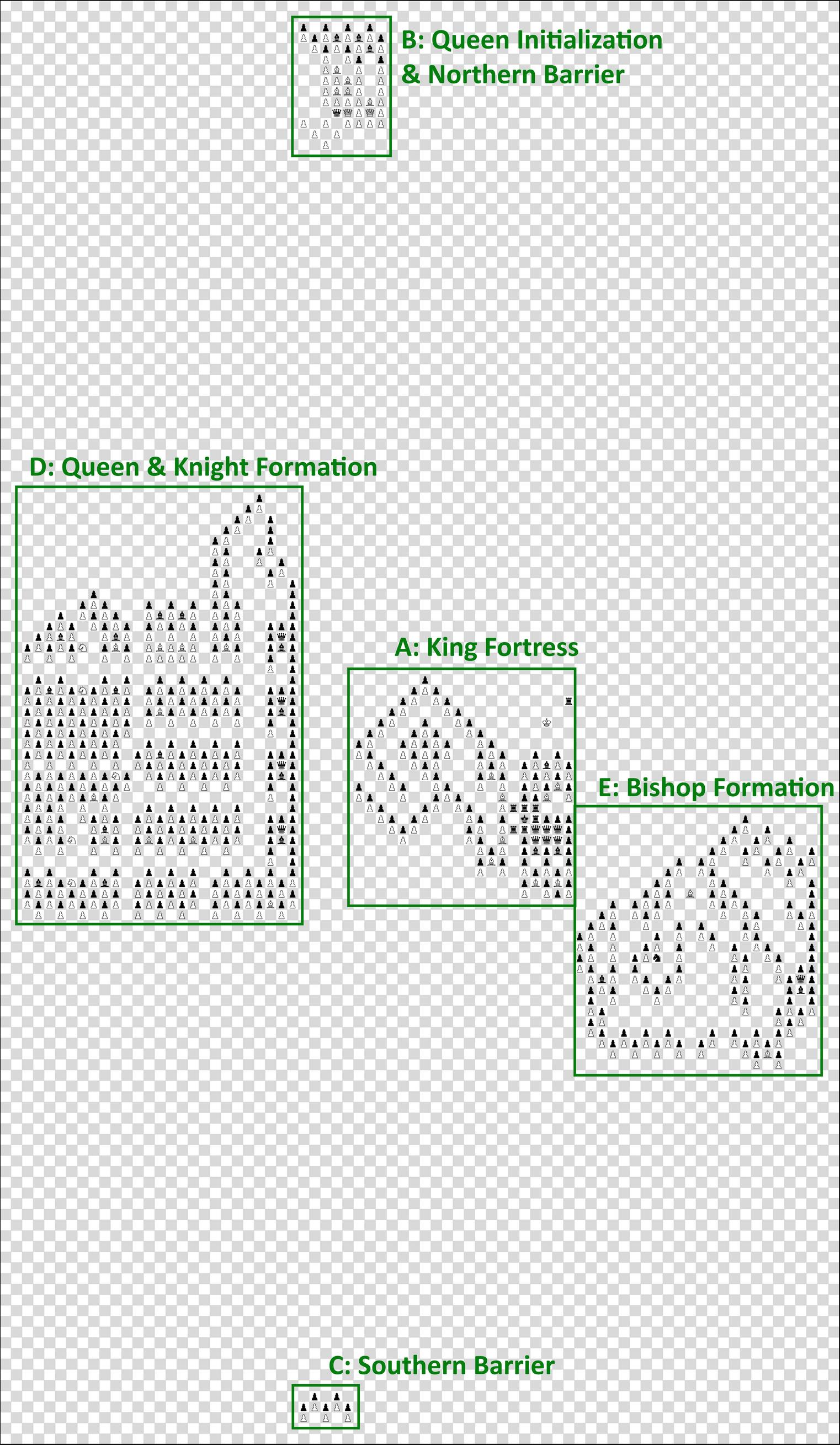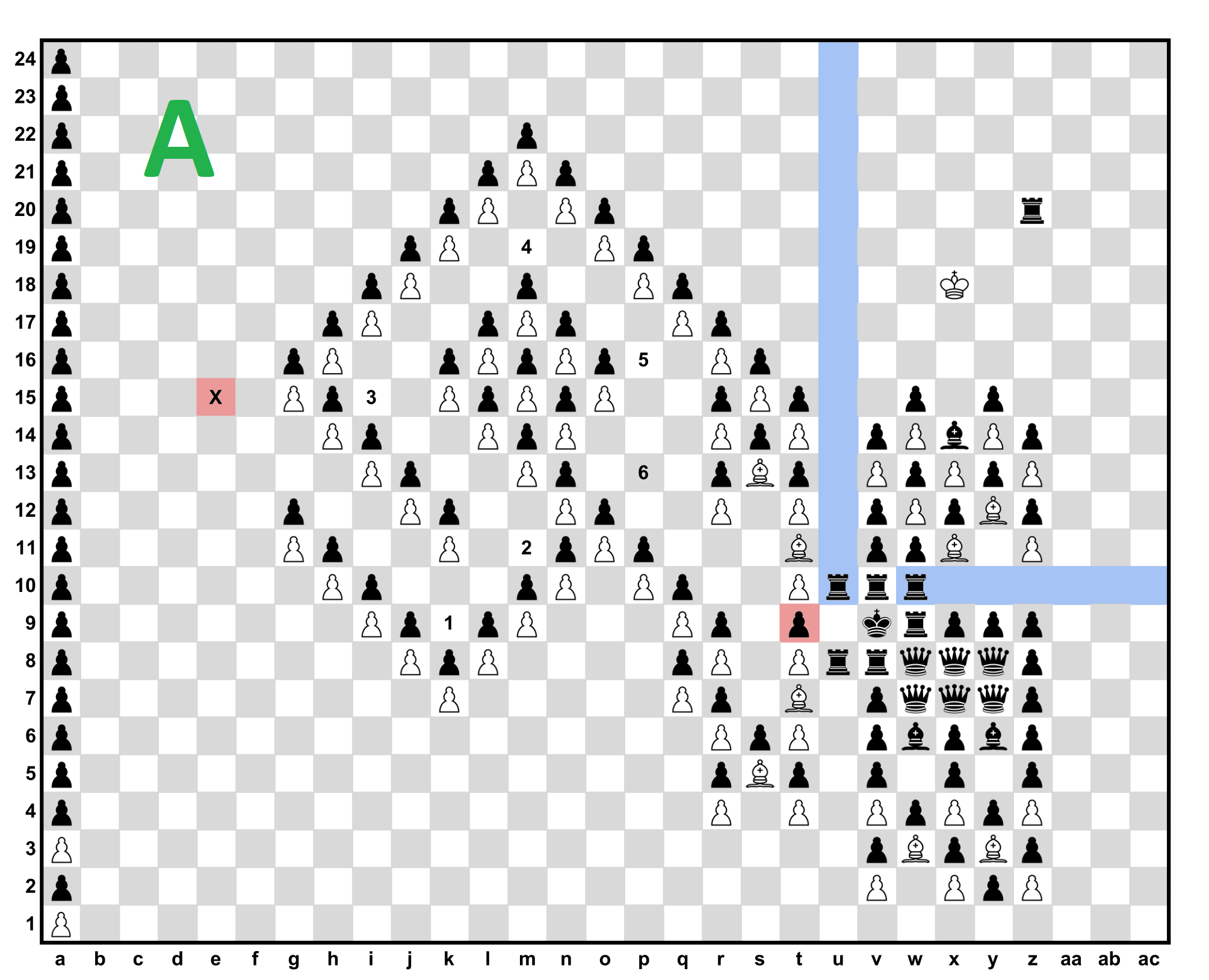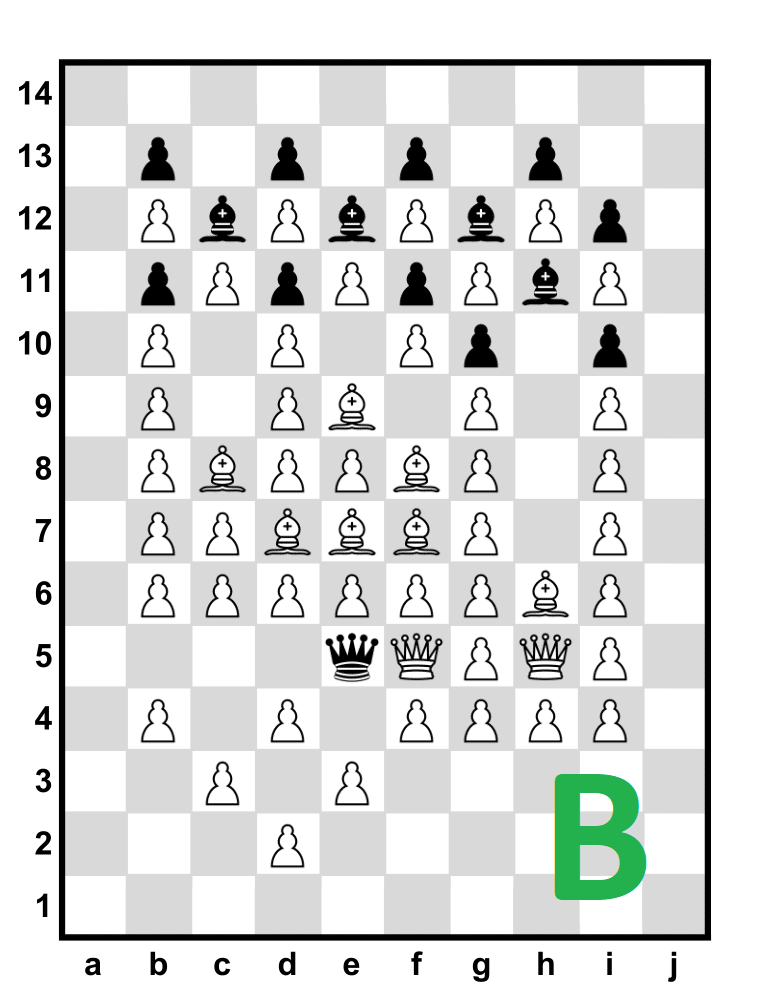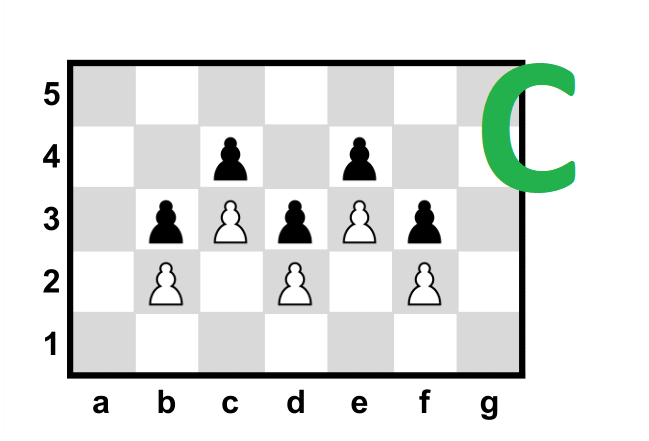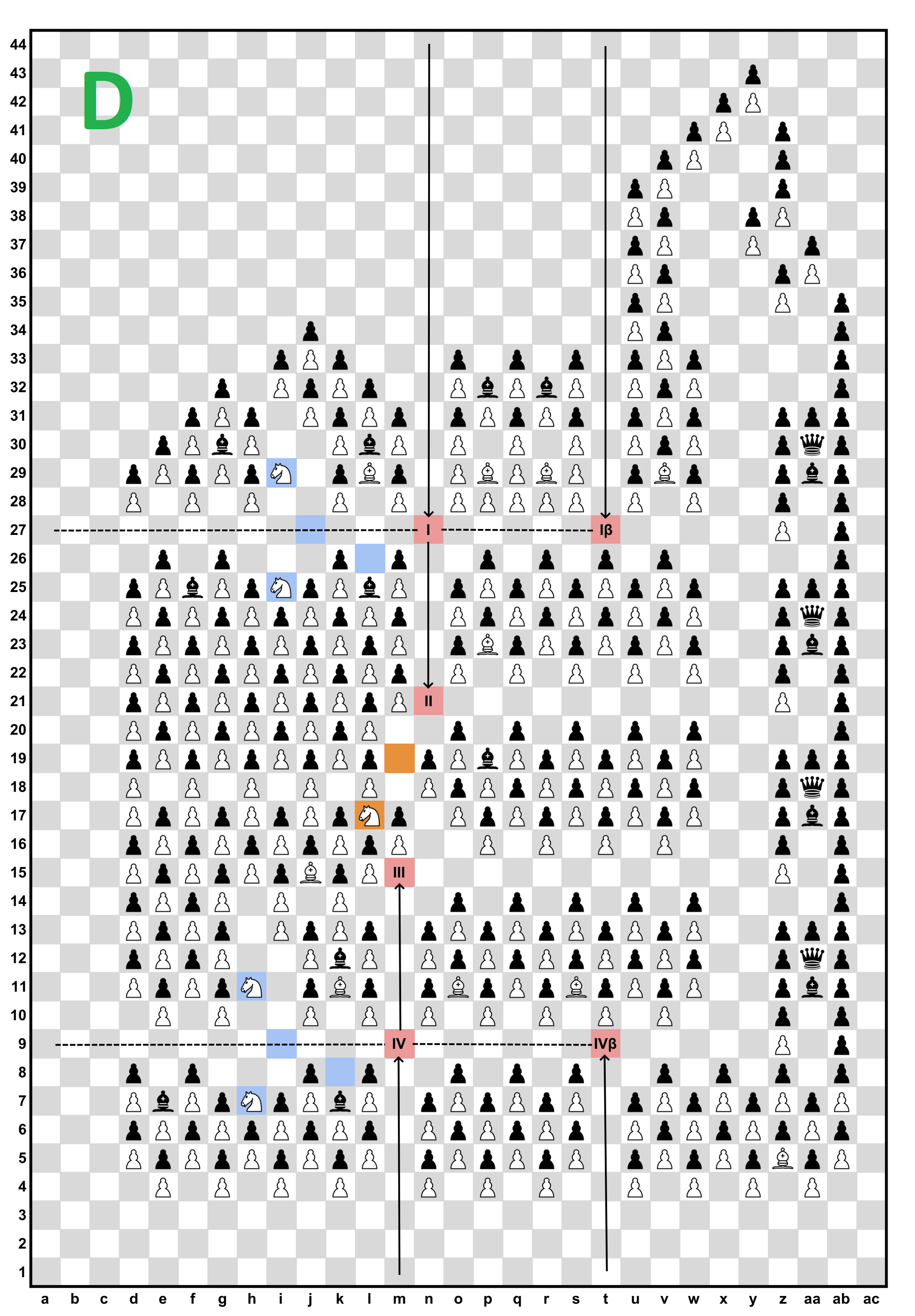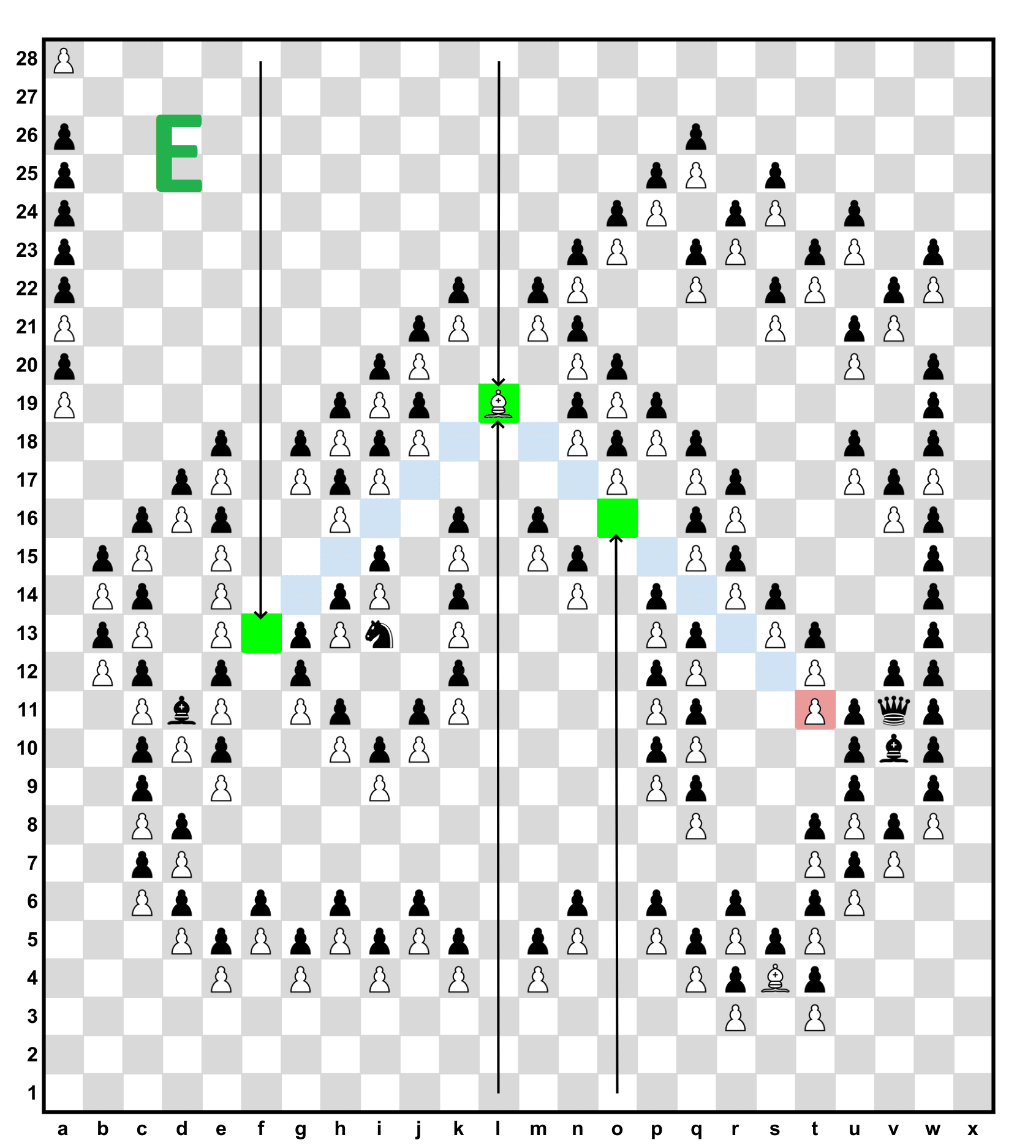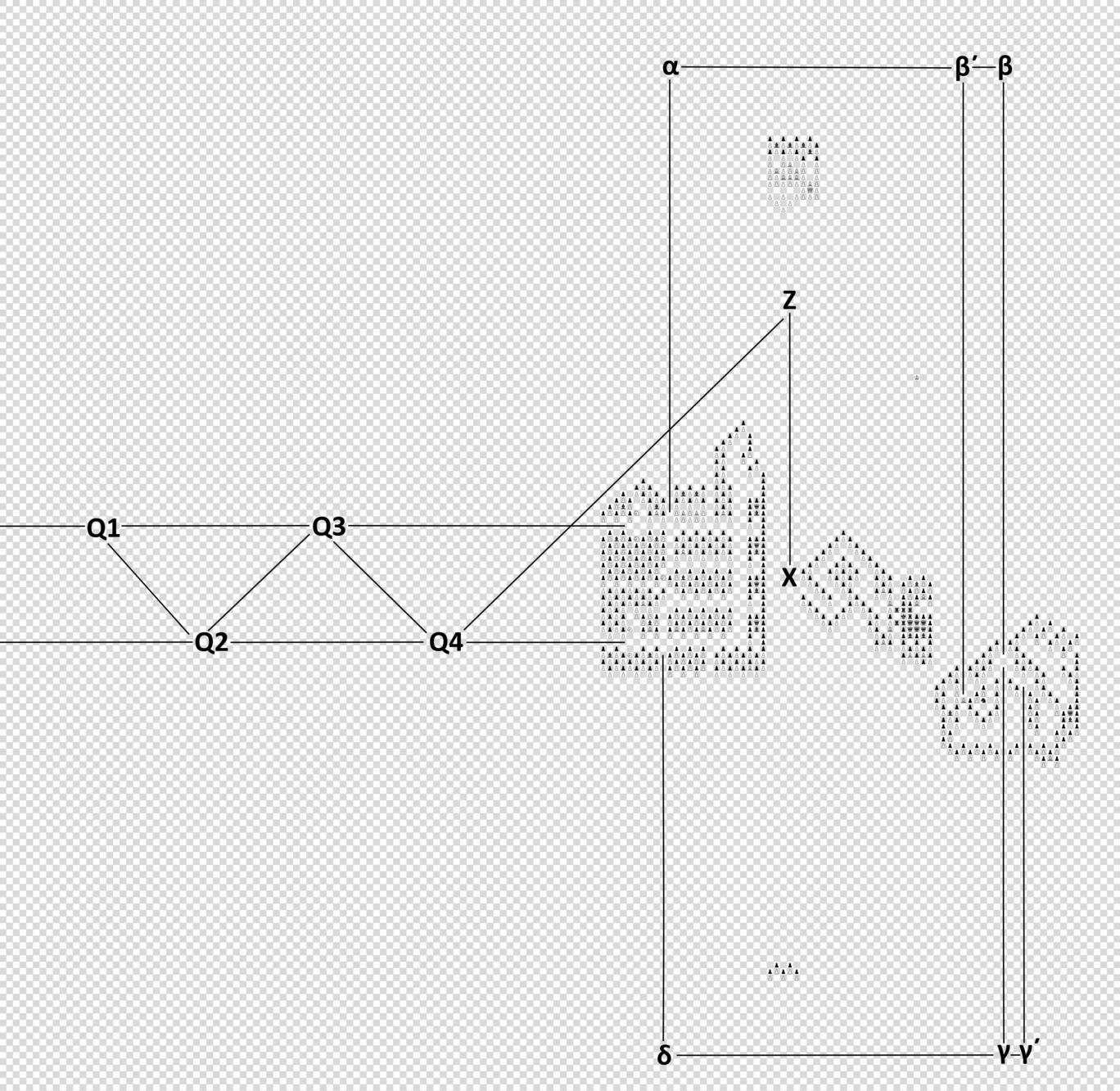A position of game value ω² with finitely many pieces
In the following position with finitely many pieces, White has mate-in-ω² (Black to move): (For convenience, I put the position into a public Google spreadsheet so that everyone can browse it at their own leisure or copy the sheet to edit it. Alternatively, click on the pictures in this post if you want to expand them or here for a high-res image of the full position.)
The basic idea of the position is that Black will lure away the White Queen to the left by an arbitrary number of moves in the beginning. The position is constructed in such a way that
White can never move his Queen back in a straight line because he has to keep answering constant threats by Black in very specific ways. Instead, the Queen has to be moved back very slowly in a zig-zag line, 18 squares at a time, in order to keep answering the threats. White will win only when the Queen has traveled back near the rest of the pieces.
Inbetween every second Queen move by White, Black can move his Rook arbitrarily far away from the White King and proceed to continuously check him in such a way that White's only resort is chasing down the Black Rook with his King.
In total, these two factors lead to a game value of ω², because Black can choose in the very beginning how often he can play the check-the-White-King-from-afar game.
Overview of the five components of the position
Now let us proceed by introducing the components of the position:
Component A is the fortress of the Black King. White has pinned several Rooks to the Black King and almost every single Black piece is completely blocked. Black can freely move exactly two pieces in the entire position during the game: his one active Rook on Az20 and his pawn on Ay2, which exists solely to prevent stalemate & zugzwang and has no further significance. (Note: I put the letter A in front of the file letter in order to unambiguously specify that I am describing the coordinates of component A.) The Black Rook cannot threaten the White Bishops in any way or disentangle his position.
There are a few noteworthy observations about this fortress: First, the White King's movement is restricted to the top right quadrant of the board by the pinned Black Rooks. Thus, if Black were to move his free Rook north and start giving checks, then White would be unable to hide his King - he would be forced to move his King north to meet the Black Rook and push it away. Secondly, White can checkmate the Black King by capturing the highlighted Black pawn on At9 with his Queen (which is the only White piece that can freely move around the entire board, as we shall see). The numbers in the position show the path that the Queen has to take through the twisting corridor in order to reach the checkmate square: If the White Queen starts from immediately outside the corridor on the red highlighted square marked with an X (Ae15), or any other outside square on the entrance diagonal, then she will need 7 moves to checkmate Black. Keep this number in mind as the game will critically depend on every single tempo. Finally, note that the entrance diagonal into the corridor is quite obstructed - the pawn wall to the left as well as the Northern and Southern Barriers completely block off any immediate access from the West or from the vertical files Ab through Af into the corridor.
Component B serves two functions: First, it serves the initialization of the free White Queen. We will see later that the optimal first move by Black is to move his queen as many squares as possible to the left - let's say N squares - which will lead to a position of a game value of ω⋅O(N). We will also see later that White is forced to immediately capture the Black Queen after that in order to prevent perpetual check onto his overly exposed King. After the first move, this Component is effectively frozen and will never be revisited under optimal play. The second important function of Component B is that it acts as a barrier that blocks files Ab through Af: no piece can directly move onto the entrance diagonal in Component A by moving vertically down from North.
Component C has an analogous role: It is the Southern Barrier and exists solely to block files Ab through Af from below.
Component D is a large defensive formation in which almost all pieces are frozen in place. Black has several trapped Queens on the right and White's has to utilize this defensive formation in order to stop Black from liberating his Queens. (Recall that the White King is completely exposed on the top right quadrant of the board and that a roaming Black Queen will lead to draw by perpetual checks.) The Black Rook can attempt to make an incursion into the formation in order to free his Queens by moving onto the files Dn and Dt from above or Dm and Dt from below, thus threatening to move onto the red marked entrance squares with the Roman numerals I through IV (and the secondary incursion squares Iβ and IVβ). Supposing, for example, that the Black Rook is somewhere far away on the top right of the infinite chessboard (let's pick Dw44 as an example), then he can free a Black Queen with the moves 1...RDn44, 2...RDn27, 3...RxDz27, 4...RDn27, 5...Dz27, 6...Dz28, 7...QDx27, 8...QDx35, 9...Black Queen checks the White King. Thus, a Black Rook in the North or South of the chessboard always threatens perpetual-in-9-moves, pending a successful incursion onto the squares with the Roman numerals.
Now let's examine how White can answer this threat: The White Knight on Dl17 (marked in orange) can defend the incursion squares II and III by jumping between the two orange squares Dl17 and Dm19. Other than that function, this Knight has no freedom of movement. The White Queen can defend the incursion squares I and IV from afar by moving between the rows D9 and D27. The four White Knights on Dh7, Dh11, Dh25, Dh29 (marked in blue) have the function of preventing an incursion by the Black Rook from the West. For instance, if the Black Rook moves to Da9, then White can defend the incursion with DN7i9. Furthermore, if these White Knights were ever to gain multiple tempi, then they could permanently block the incursion squares I and IV by using the blue colored squares, for example by playing 1.DN7i9 (which blocks squares IV and IVβ from the left) 2.DNk8 (which blocks square IV from below) 3.DNhi9 (which permanently blocks squares III and IV from all directions). This is slow but would permanently eliminate some of Black's threats, which puts pressure on Black to not stay idle and prevent this with new threats.
We are now ready for an important observation: During the game, the White Queen will mostly zig-zag between rows D9 and D27 to answer threats, as we will see later. If the White Queen is very far away on the left of the board on one of these two rows, then it can reach the entrance diagonal of the Black King's Fortress (e.g. square Ae15) in 3 moves. (Look at the entire board configuration to convince yourself of this fact.) Recalling our analysis of the corridor, White thus threatens checkmate-in-10 assuming no Black counterplay. This is a tempo disadvantage for White: he needs 10 moves to checkmate but Black can typically start giving perpetual check in 9 moves if the White Queen abandons its defensive post! However, this situation drastically changes, once the White Queen has approached the position and is within 20 squares to the left of the file Da. Then the White Queen can move diagonally onto the files Ac through Af between the two barriers and reach the entrance diagonal one move faster. Thus, White's approach is rewarded with a tempo, yielding a checkmate-in-9 threat!
Finally, Component E is a defensive formation guarded by a lonely undefended White Bishop, the only moving piece in the position, which guards the marked pawn on Et11, so as to contain a trapped Black Queen. In the position pictured above, assume that the Black Rook is on the square El28 threatening the White Bishop on El19. Assuming that White does not answer the threat, Black will free the Queen by playing 1...RxEl19 2...REl7 3...REs7 4...REs11 5...RxEt11 6...QEu12 7...QEu16 8...QEr19 9...Black Queen checks the White King, i.e. Black again threatens perpetual-in-9. Thus, White is best advised to move his Bishop out of the way. The movement of the Bishop is quite restricted, in fact it can only ever visit the three unguarded squares marked in bright green: Ef13, El19 and Eo16 (the latter two squares have a view of the important pawn). In the situation from before with the Black Rook on El28, the White Bishop should move to the right, i.e. BEo16, because moving to the left would simply result in a repetition of moves, i.e. 1.BEf13 REf28 2.BEl19 REl28, since the left green square can only be attacked from the North while the right green square can only be attacked from the South. Thus, conversely, if Black were to threaten the White Bishop from below, then the White Bishop has to move away under cover, since any capture of the Bishop on any of the three green squares results in perpetual-in-9.
Note that other than that, the position in this component is completely frozen. Any movement by the Black Knight on Ei13 is completely pointless - the Knight exists only in order to guard a few squares from the White Bishop. Moving the Knight to Eg14 or Ej15 results in immediate capture by a pawn or bishop, if available, and the White Bishop gains a safe square on Eh15. Moving the knight to Eh15 can either be answered by capturing it with the Bishop or, in case the White Bishop is on Eo16, it can be safely ignored until it is captured by the Bishop in the future, since all further moves of the Black Knight to Ef16, Ef14, Ej16 or Ej14 can be answered by pawn captures. Thus, Black strictly improves White's position by moving the Knight. Also, Black simply wastes time by going after the critical pawn without having removed its defender since he needs more moves to enter the interior of the Component and threaten it than White needs moves to answer the threat.
The opening move
What will happen in the beginning of the game? Let's examine the possible moves by Black and the best answers by White:
Black moves his free Rook anywhere. At best, Black now threatens perpetual-in-9 by one of the methods described above. White captures the Black Queen with Bfxe5 and threatens mate-in-8 because the White Queen is already in the line of sight of the entrance diagonal. White wins almost immediately.
The Black Queen captures any pawn. White can capture it back and threatens mate-in-9 because the Queen can reach the entrance diagonal in two moves. Black to move does not threaten perpetual-in-9 yet. White wins almost immediately.
The Black Queen captures the White Queen. White answers with Bgxf5. White threatens mate-in-9 with its newly liberated Queen. Black to move does not threaten perpetual-in-9 yet. White wins almost immediately.
The Black Queen moves far West. The Black Queen threatens perpetual-in-1. White has no choice but to capture it and, thus, move his Queen far away. Black then moves his Rook up an arbitrary number of squares and threatens perpetual-in-9 in Component D. (Making a threat in Component E and crossing it does not work just yet, as we will see below, because the White Knight in Component D is in the bottom orange square.) White cannot checkmate in 9 moves by moving the Queen back and, thus, he has to answer the threat by defending it with his Queen and Knight after Black moves to file Dn. (We will see below which responses for White work and which do not.)
Let us now see how a typical sequence of moves in the bulk of the game looks like:
A typical game sequence
Assume the position above with the Black Rook on α, the White Queen on Q1, the defending White Knight on the upper orange square and the defending White Bishop on the left green square. White has just defended the Black incursion from the file Dn and the Black Rook needs to make a new threat - since he does not threaten perpetual-in-9 (Thus, Black passing the turn would allow White to immediately move his Queen to the right and threaten mate-in-9). Black moves to square β΄ and threatens the White Bishop. The White Bishop has to move to the central green square. Black moves to square β and the White Bishop moves the right green square. The Black Rook cannot threaten the Bishop anymore and moves his Rook to square γ (Any move in another direction would just waste a tempo). Now Black threatens an incursion from the file Dm in two moves and White thus moves his Queen to square Q2. Black proceeds by moving his Rook to the square δ, which White has to answer by moving his knight to the lower orange square. Now Black moves his Rook to γ΄, the White Bishop has to run to the central green square, Black responds by moving to γ, White moves his Bishop to the left green square, and then, finally the Black Rook moves up in the direction of square β, to which White responds by moving his Queen to Q3. Here, the transfinite ω has come into play! Namely, the "new" square β can be as arbitrarily far North from the White King as Black wishes! Now Black can start giving checks to the White King from above and the White King is forced to approach the Black Rook - this might take many moves. One move before the White King reaches the Black Rook, Black moves his Rook to square α and White has to move his Knight to the upper orange square in defense - he has just made it in time. This closes the loop and the position is exactly the same as before, except that the White Queen is now on Q3 instead of Q1, i.e. it has moved 36 squares to the right in ω+8 moves. This loop continues until the White Queen reaches Q4, which is sufficiently near to the Barriers in order to allow the White Queen to dip between the two Barriers, which improves White's imminent threat from mate-in-10 to mate-in-9. As soon as the next position is reached where Black only threatens perpetual-in-9, White can ignore the threat and proceed to checkmate Black.
Remarks, deviations from the strategy above and their refutations
The only strategic deviation which allows Black to constantly stay in threatening-to-perpetual-in-9 positions is to disregard Component D and just keep moving his Rook between squares β,β΄,γ,γ΄, checking the White King and threatening the White Bishop in a loop. However, inbetween every move between β and γ, White can move his Queen a bit closer, like in the example above. Thus, every loop of this strategy consists of ω+4 moves instead of ω+8 moves as above.
Black should not typically threaten the secondary incursion squares Iβ and IVβ (Dt9 and Dt27) since this threat is strictly weaker than the threats on the files Dm and Dn, under typical play.
If Black ever moves his Rook to the far left, then White can immediately move his Queen right to Component D in a straight line because such a move by Black is no threat. The blue-colored knights in Component D prevent any incursion from the left in a single move, if needed - thus Black has created no new threat and just wasted a move. If Black moves his Rook onto rows D9 or D27, white defends with a blue knight, threatens mate-in-9 and will win very shortly. Similarly, Black cannot ever capture any nonsignificant White pawn or move his Knight in Component E since this wastes too much time.
A long horizontal move by the White Queen to the right at any point in time results in a draw because Black makes a new perpetual-in-9-threat every single move that needs to be answered, either by moving the Bishop or Knight or by changing the row of the Queen. Thus, White has wasted a critical move and cannot answer the next Black incursion attempt.
A long diagonal move by the White Queen to the file El in order to defend the White Bishop is pointless because the Black Rook can just move back to α or δ respectively, threaten an incursion into Component D again, and force the White Queen to undo its last move.
A long diagonal move by the White Queen to the files Dm or Dn as a defense against the Black Rook having reached squares β or γ is pointless, because the Black Rook can just immediately threaten the the secondary incursion squares Iβ and IVβ, and the White Queen has no choice but to revert its last move. (These secondary incursion squares exist solely for this reason.)
If the White Queen at any point in the game and under any circumstances (such as after the first move in the previous bullet point) enters the interior of Component D, then White cannot win anymore since the Queen will find it impossible to exit the Component and checkmate in less than 10 moves. While White can theoretically try to keep defending Black's incursion threats by rotating his Queen between the squares Dx9 and Dx27, he can no longer make progress in the position and reach the ciritcal entrance diagonal sufficiently fast.
The Black Rook needs to be careful to choose its distant squares α, β, γ and δ in such a way that the White Queen cannot interfere with the Rook diagonally. This is always possible for Black since he can move his Rook sufficiently farther away vertically than the horizontal distance to the Queen.
The White King needs to be careful in the end to stay away from certain diagonals, namely those that release the Queens out of Components D and E, else Black will have a threat of perpetual-in-8. This is possible for White since he has enough freedom of movement with his King to do so.
White cannot prevent the check from the Black Queen solely by moving his King to a suitable position on the top right quadrant, because both Components D and E give the respective Black Queen several exits that are spaced sufficiently far apart. (For instance, in component D, the Black Queen can choose between the squares Dx32, Dx35 and Dx40 on the move before initiating perpetual checks.) The Black Queen will always be able to threaten the undefended White King vertically or horizontally.
Disclosure: I have also posted this analysis on Chess Stack Exchange to ask for feedback and a review by chess players.

